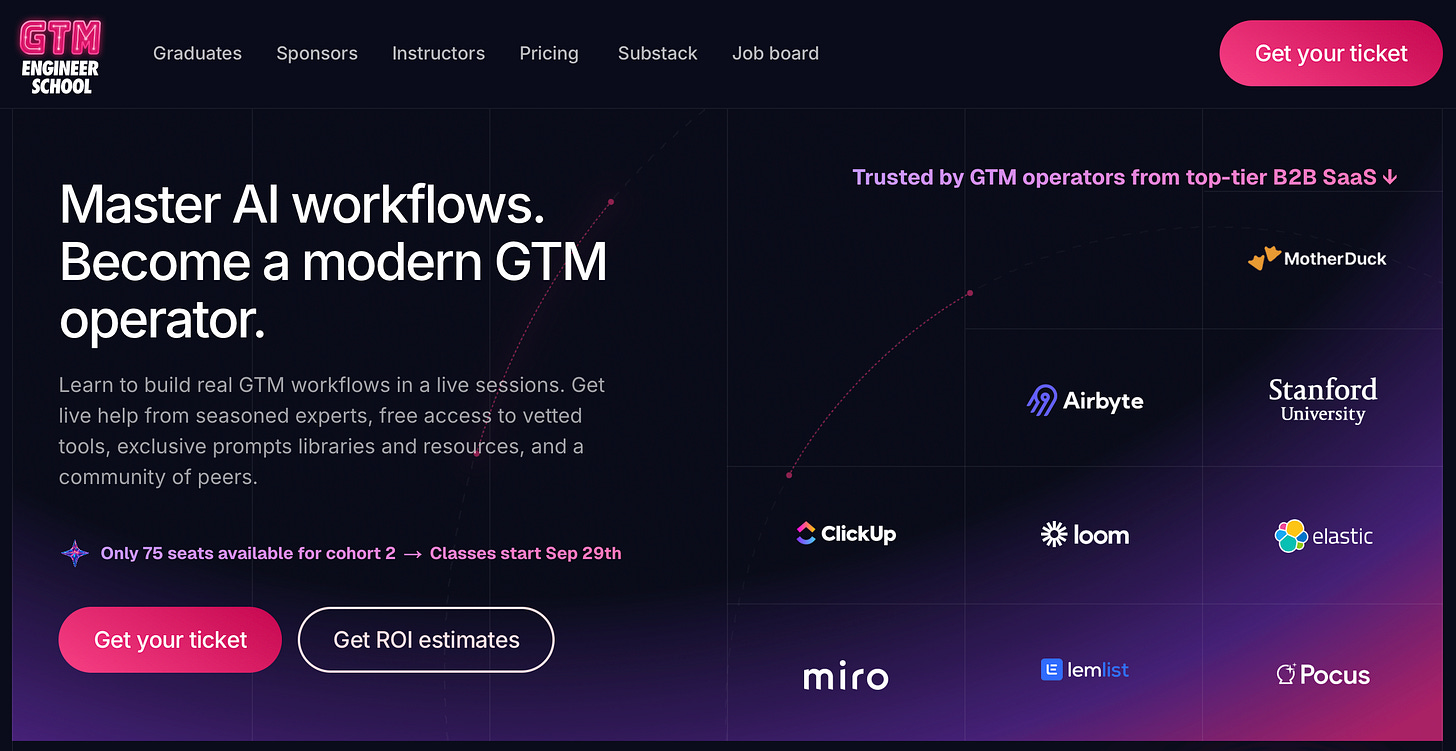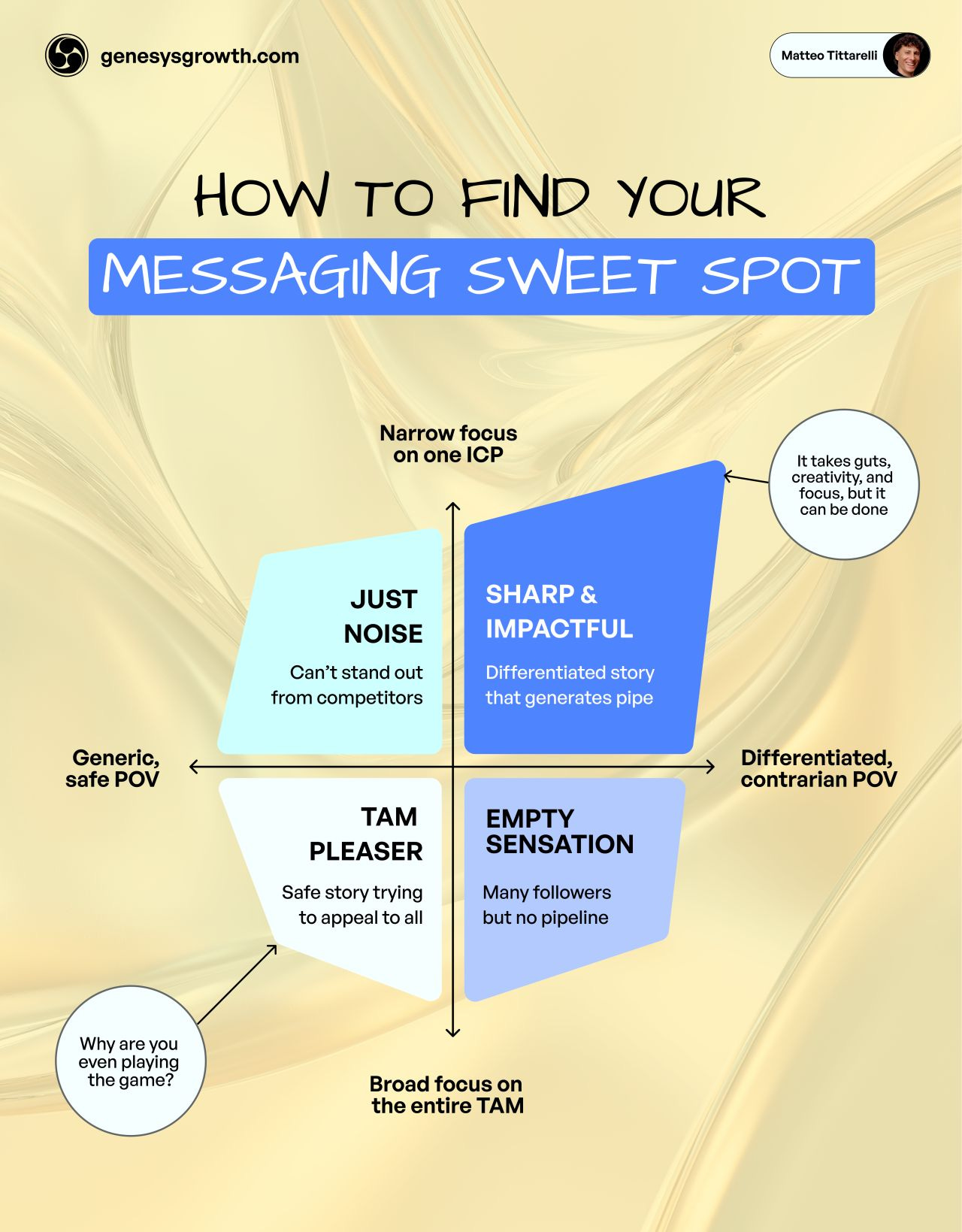How to find your messaging sweet spot
Messaging isn’t about volume or extreme focus alone.
Most GTM operators never scale beyond manual outbound. If you want to break the cycle and build AI-powered workflows that actually generate results, join cohort 2 of GTM Engineer School.
A 5-week live cohort for GTM operators who want to master scalable, AI-driven workflows that deliver measurable ROI.
From messaging to sequence/content: Each week = 1 complete workflow system.
Step-by-step builds with Octave, Clay, n8n, Cargo, and AirOps.
Featuring expert instructors from top GTM teams + breakouts for hands-on support.
$7000 worth of tool credits included + prompt libraries + certification.
ROI projection: 375-848% based on 5-10 hours saved weekly.
Cohort 2 starting in 10 days (Sep 29th) → Get 15% off your ticket by clicking below.
And now on today’s post!
Most B2B SaaS teams get trapped in a false choice: broad reach or sharp focus. But the real choice is simpler and more important than you think.
Your messaging strategy sits on two critical axes that determine whether you generate pipeline or just noise.
The messaging matrix that reveals the trap
Every SaaS company falls into one of four messaging quadrants based on how they balance audience focus and point of view:
TAM pleaser (Broad + Generic) Safe story trying to appeal to everyone. You sound exactly like your competitors because you're afraid to take a stance. Result? Lots of website visits, zero pipeline velocity. If you’re in this quadrant, ask yourself: “Why are you even playing the game?”
Just noise (Narrow + Generic) You've identified your ICP but your story is bland within that niche. "We help Series B fintech companies optimize processes." You can't stand out from competitors who target the same slice with equally safe messaging.
Empty sensation (Broad + Differentiated) You have a contrarian take that gets attention, but you're speaking to everyone and no one. Lots of LinkedIn followers, podcast downloads, and "thought leadership" credits. Pipeline stays flat because nobody feels specifically called out.
Sharp and impactful (Narrow + Differentiated) The sweet spot. You combine laser focus on one ICP with a differentiated story that challenges how they think. This generates actual pipeline because the right people immediately understand why they need you now. Now, I know what you think, but it takes guts, creativity, and focus, but it can be done.
Why the sweet spot works
When you nail narrow focus plus contrarian POV, three things happen that directly impact your pipeline:
Ready-to-buy prospects self-select in. Your messaging acts like a filter. Time-wasters bounce off, but qualified prospects think "finally, someone who gets our specific problem."
Deal velocity accelerates. Sales conversations start with context instead of education. Prospects already understand your differentiated approach before the first call.
Competitive differentiation becomes automatic. You're not fighting feature wars or price wars because your positioning is fundamentally different from alternatives.
The hard truth about positioning
Most founders avoid the sweet spot because it feels risky. Narrow focus means saying no to potential customers. Contrarian POV means some people will disagree with your approach.
But here's what's actually risky: trying to please everyone while standing for nothing.
The TAM pleaser approach feels safe but kills conversion. The empty sensation approach gets ego validation but not revenue validation.
Your messaging audit
Ask yourself these two questions:
Focus test: If I removed my company name and logo from my website, would my ICP immediately know this message is for them specifically?
Differentiation test: Does my core message challenge how my market thinks about the problem I solve, or does it sound like everyone else?
If you can't answer yes to both, you're not in the sweet spot yet.
Where does your current messaging land on this matrix? Book a call with me to strategize which quadrant you want to be in.
Making the shift
Moving to sharp and impactful messaging requires three decisions:
Choose your ICP ruthlessly. Not "mid-market companies" but "Series B fintech startups struggling with compliance automation after their first regulatory audit."
Develop a contrarian thesis. Challenge conventional wisdom and current alternatives about how your problem should be solved. What does everyone else get wrong?
Have the courage to polarize. Some prospects will disagree with your approach. You’ll upset some incumbents. That's the point. You want the ones who resonate strongly, not the ones who sort of agree.
The sweet spot isn't comfortable. It's the only profitable way to stand out in the sea of sameness of the AI era.



